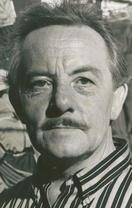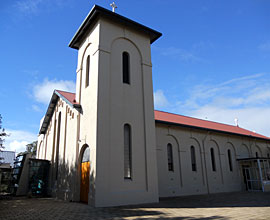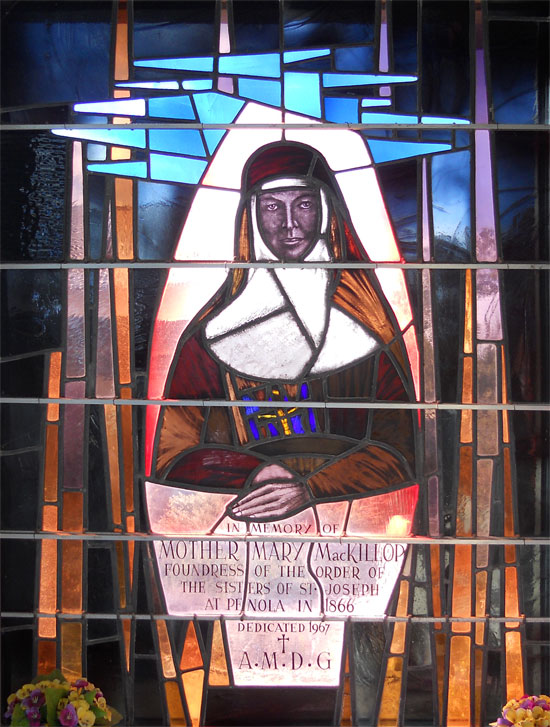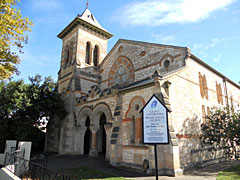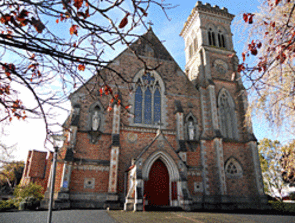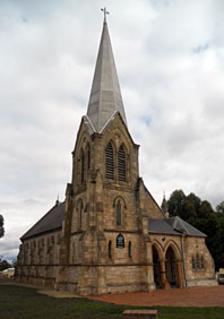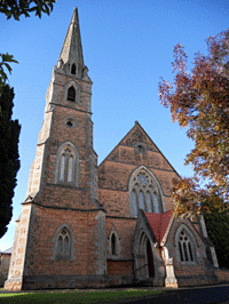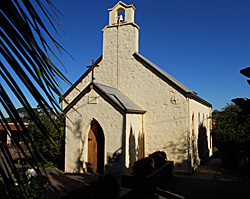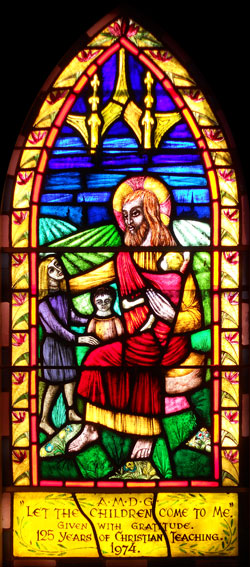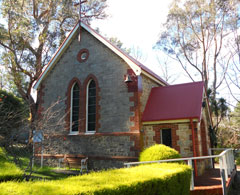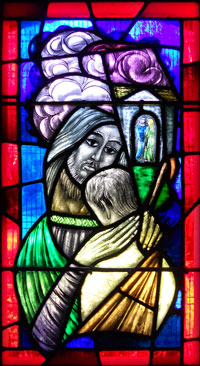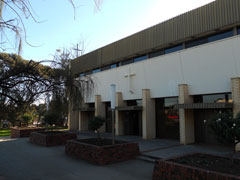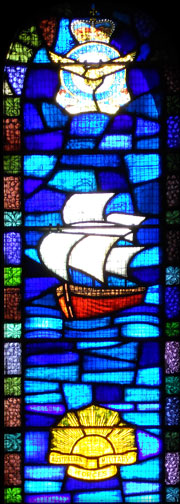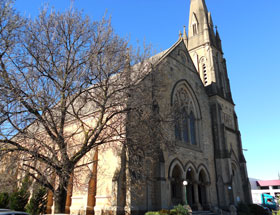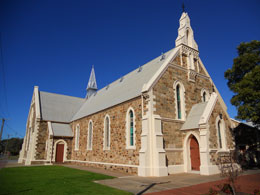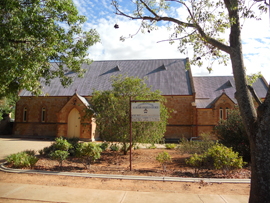All the information contained on this website is from Jean's personal correspondence with his patrons & family,
collated by Noel and Rachael Orval.
Jean also completed a window for the Woodville Presbyterian
Church in 1970, however when that church was closed, it was
re-installed graciously, into the Woodville Uniting Church.
In November of 1969, the Board of Management agreed to
commission Jean to produce a stained glass window in memory
of Jean Drummond, organist of this church 1930-1967.
Miss Marjory Hartley corresponded with Jean regarding this
window and expressed that Miss Drummond "was interested in all kinds of people and a considerable number of her working hours were spent in teaching children to play the piano."
Jean found working with the Board of Management, Miss Hartley and Sessions Clerk Mr W. Sim a "breath of fresh air" declaring that there wasn't any restraining instruction on how this window should be portrayed, which enabled Jean to work in a artistic freedom as opposed to following a normal religious composition.
In April of 1970, the window was installed and a dedication service was held on April 12.
Miss Hartley wrote to "express my delight at the beautiful window in memory of my close friend. I'm sure everyone is pleased with it."
Sessions Clerk Mr W. Sim wrote "Members of the Drummond family expressed their approval of it and commented upon its beauty and attractiveness. At night when the church lights are on, it shows up quite well from the street and should attract those who pass by - we wanted it to be a form of witness to the casual observer as well. We realise more than ever now, that you have treated us very generously and want you to know how sincerely this has been appreciated by those of us who have been closely associated with the project."
Jean was commissioned in 1965 for 2 stained
glass windows in memory of the McCorquindale
family of "Moerlong".
The windows were of "Jesus In The Garden", with
the inscription of "Not My Will But Thine Be Done".
The second window depicts the "Light Of The World".
The dedication service was attended by many
relatives and friends including Mr and Mrs Gordon
Cameron of Beachport, Mr and Mrs A. Peake of
Adelaide and Mrs Carter of Millicent.
Reverend David Fotheringham dedicated the
memorials and said that "today Australia was being
enriched by new settlers like Mr Orval."
The last remaining window in the church by Jean,
was commissioned in 1966.
The window was of "The Sower", with the
depiction being "The Word Of God Remains Forever",
in memory of Neil William Drury-Foster of Glenroy, by
his parents, who was tragically killed in a tractor
accident at the age of 21.
The effective figure indicated youthfulness with a
background of grassland, birds and trees depicting a
love of the country and an open bible, his evidence
of faith.
Jean was to have another association with Reverend
David Fotheringham, when he dedicated the Kerr
Memorial Window at Cobden in December of 1973.
Please click on a town
Classified:
National Trust
Gothic style sandstone church, begun
in 1874 and the spire was added
the following year.
Jean was approached in 1963 to
construct a memoria l window for
their much loved parishioner, Edith
Emilie (Cameron) Grieve.
Edith was born at "Satimer Station",
Wando Vale in 1871 and died in
Kingston, South Australia in 1945.
She was married to Samuel Fordham
Grieve, one of the first graziers to
import Black Angus cattle to South
Australia when he managed a property
for the Robertson family between
Penola and Naracoorte.
The depiction was of a "Kneeling Mother"
with the inscription of "Blessed Are The Pure In Heart For They Shall See God."
The next window to take its place in this magnificent church was one of "The Good Shepherd" in memory of John and Margaret Thomson. Jean was first approached by Mrs M. and Mrs N. Batt of "Kooladdy" in July of 1966. After many designs, the family finally settled on a completed composition and it wasn't until May of 1967 before all the necessary approvals were received and Jean could start the window in earnest.
Jean completed this particularly striking depiction of "The Good Shepherd" in late August 1967 and the window was installed and dedicated in the first week of September.
The third and last window to grace the walls of this church was "Ye Are The Salt Of The Earth".
Mrs R. C. Smith first wrote to Jean on June 5, 1968 requesting a sketch and quote. Because Jean was leaving for a studyship on the Continent later that year, Jean wrote to Mrs Smith that he would be unable to complete a window before he went, but he would design a sketch for her.
Jean had to attend a lecture at the Methodist Fellowship in Naracoorte on June 23 and it was while he was there that he made the necessary measurements and tracings. Then he met with Mrs Smith at her home because "we like to talk to you for a few minutes to make sure that you will get a window which will please you."
Jean made a design that was approved by the Church Session in late August 1968. The inscription was to Adam Smith 15/4/1815 - 17/3/1876, William Smith 17/2/1849 - 30/4/1913 and William Robert Smith 30/3/1889 - 15/2/1968.
When Jean returned from Europe, Mrs Smith had written that "we are all pleased with the design. I am returning your sketch together with two cheques to cover the first two phases of the work."
By the end of November the window was completed and installed and Mrs Smith was delighted with the window and how beautiful it made the church look."
"Kneeling Mother"
St Andrew's Presbyterian,
Naracoorte, SA - 1963
"Ye Are The Salt Of The Earth"
St Andrew's Presbyterian,
Naracoorte, SA - 1968
"The Good Shepherd"
St Andrew's Presbyterian,
Naracoorte, SA - 1967
Jean was approached by Architect
Stewart Blore concerning a memorial
window for Mother Mary MacKillop in
May of 1968.
Jean made a sketch after receiving relevant
information about Mother Mary and the Sisters
of St Joseph, prior to leaving on his study trip
to Europe.
In December, Stewart Blore wrote to say that
"Father Gleeson had approved the sketch and
the quotation he accepts."
This window was constructed in applique glass
which is a glass brought together with transparent
glue with the only place applying this technique
being the studio of Van Tetterode in Holland.
The work was expensive, however the outcome
was fitting of a woman held in such high regard.
When the window was installed at the convent on March 8, 1969, the Sisters "were all very happy with the panel and kept praising it, but not Father Gleeson ... he did not show any interest at all because he could not read the lettering from the outside. I am pretty sure that Father Gleeson has been thinking that it would be possible to see the whole lot from the outside, the picture as well and that's only because he does not have a clue that stained glass can be seen to its full advantage only from one side," as Jean expressed in his correspondence.
The window was moved out of the porch at St Joseph's Convent and a special shrine was built at the back of St Joseph's Catholic Church in 1998, for a place of quiet reflection and prayers.
"Saint Mary MacKillop"
St Joseph's Catholic Church, Penola, SA - 1969
"The Sower"
St Andrew's Presbyterian,
Penola, SA - 1966
"Jesus In The Garden"
St Andrew's Presbyterian,
Penola, SA - 1965
"Light Of The World"
St Andrew's Presbyterian,
Penola, SA - 1965
Classified: Heritage Listed
The pink Dolomite church was
opened December 10, 1871. An
earthquake at Robe in 1896
destroyed the spire but by the 1920s,
a decision was made to rebuild
the spire but they ensured it was the
highest in town by adding another
10 feet.
Jean was approached by Session Clerk
Murray Martin on July 26, 1971, concerning
the proposed installation of a stained glass
window in memory of the late Reverend
W. L. Collins at St Andrew's.
Things moved languidly and it wasn't until Sunday, February 6 that Jean was able
to visit the church to make measurements and speak to the committee concerned
who were dealing with the memorial. Jean supplied the Committee and Church
Session with 3 designs in which to choose or make suggestions to their liking.
The donor family procrastinated for months and it wasn't until September 25,
1972 that permission was finally given to proceed with the window. The double
window encompassed the elements of bread and wine, with the overall theme
being that Christ shares with us at His table so that we can share His love with
the world.
The window was completed and installed in December 1972.
A dedication service and unveiling of the finished product was conducted on
Sunday, March 11, 1973 by the Reverend A. Yule and attended by over 600
people. Reverend W. L. Collins received many special tributes throughout the
service with Rotarians remembering a man who gave service beyond self.
Returned Service League members remembered the outstanding war record
that resulted in the high honour of Life Membership bestowed on him; and
one "Rat of Tobruk" who recalled his first meeting with Padre Collins in a gun
pit at Tobruk, when he was given chewing gum and writing paper by Reverend Collins.
Murray Martin wrote Jean to say "we deeply appreciated the fact that you saw fit to
make the journey to Mount Gambier. The window has drawn forth many favourable
comments and from remarks passed by all members of the Collins family who were
present at the service, they are very happy indeed with the completed window."
"Reverend W. L. Collins Memorial Window"
St Andrew's Uniting Church,
Mt Gambier, SA - 1972
"The Trinity"
St Paul's Catholic Church,
Mt Gambier, SA - 1968
"Faith, Hope & Charity"
St Paul's Catholic Church,
Mt Gambier, SA - 1967
"The Conversion Of St Paul"
St Paul's Catholic Church,
Mt Gambier, SA - 1966
"Annunciation"
St Paul's Catholic Church,
Mt Gambier, SA - 1966
"Baptism"
St Paul's Catholic Church,
Mt Gambier, SA - 1966
"Resurrection"
St Paul's Catholic Church,
Mt Gambier, SA - 1966
"Redemption"
St Paul's Catholic Church,
Mt Gambier, SA - 1966
"Peace"
St Paul's Catholic Church,
Mt Gambier, SA - 1966
"Eucharist -
The Mystical Body"
St Paul's Catholic Church,
Mt Gambier, SA - 1966
"Vine And Branches"
St Paul's Catholic Church,
Mt Gambier, SA - 1966
In true personal style these depictions have a striking, challenging, modern touch.
This and their absolute clarity may explain their almost universal appeal. Jean considered these to be some of his finest symbolic works.
Classified:
Heritage Listed
The church, made of
pink Dolomite, was
erected in 1855 and is
particularly noticeable
because of the
castellated tower on
the left had side.
Jean was first
approached by the Monsignor Reverend R. M. Redden to compose 8 symbolic windows for the newly established extension onto the back of the church in late 1965.
Jean completed the 8 windows in 1966, with 2 further windows "Faith, Hope & Charity" in 1967 and "The Trinity" in 1968, both measuring 20 foot by 3 foot.
Faith, Hope & Charity (1967): 3 angels are depicted in this window, each holding a crown made from crosses (faith), anchors (hope) and hearts (charity). These 3 symbols are repeated and imposed over the text at the base of the window.
Vine and Branches (1966): The symbol XP for Christ grows from the vine which embraces the earth and is infused from heaven. We are the branches, bearing rich fruit.
Eucharist - The Mystical Body (1966): Symbols of Eucharist are used here - wheat and grapes in the upper section, loaves and fish in the lower.
Peace (1966): Symbols of peace shown in this window include doves, an olive branch and the orb of Christ "the Prince of Peace".
Redemption (1966): The 3 crosses of Calvary are featured here with an unwound sheet draped over the central cross (a symbol of the Lord who died on the cross and was raised from the dead for our redemption).
Resurrection (1966): The story of the Resurrection is told in this window in symbols. The phoenix represents the risen Lord for it was believed that after the bird died it rose to life out of the ashes.
Baptism (1966): The baptism font is in the lower section.
Expanding into the upper section are (1) the white garment of new life, (2) the candle that symbolises the risen Christ whose life we share in baptism, (3) Credo (I believe) the first words of our baptismal promises.
Annunciation (1966): This is an unusual way of depicting the announcement to Mary that she was to be the mother of the Lord. Ave was the angel's greeting. The lilies represent Mary. The root of Jesse, shooting with a branch bearing a crown is Jesus whom she is to conceive and bring forth. The dove is the power of the Most High overshadowing Mary.
The Conversion of St Paul (1966): 2 symbols of the saint, the patron of this church, are used in this window - the sword and the parchment. Both represent his power as the inspired author of much of the New Testament.
The Trinity (1968): It is unusual to depict all 3 of the persons of the Trinity in human form. The Father holds the symbols of the Kingdom (orb and sceptre); the Son the symbol of our redemption (the cross) and the Holy Spirit has the symbols of our inspiration (the Bible and dove which represent the Spirit's presence).
The Aldgate Church of
Ascension is a traditional
style church of simple
stone and brick measuring
20' x 30'.
The foundation stone was
laid on October 22, 1898.
An extension of a little over
3 metres was constructed
at the eastern end and a
porch and vestry were added in 1961.
Church Warden, E. M. Seymour initiated contact with Jean on
August 30, 1967 requesting further particulars as to a possible
window in memory of Father Raymond Baron Cornish 1884-1963.
It was thought that the window should symbolise St Thomas
a'Becket as Father Cornish was for 17 years, the Hospitaller at
St Thomas' Hospital in London.
Following this first correspondence, two parishioners, Mr Norm
King and Miss F. M. Nicholas, ventured to Jean's Hamilton studio to
view some of his creations in progress and to learn more about the
fundamentals involved in creating stained glass. Both were impressed
with Jean's compositions and duly reported that their memorial
window could not be in a better craftsman's hands.
On October 23, Jean presented his sketch for approval, noting
that it "would not be any more than a suggestion. Especially the
colours of the glass, can not really be shown on paper."
Mr Seymour passed the details on to the Bishop for his approval
"which we expect daily", on November 12. By December 6,
Reverend F. J. Hopton wrote that the Bishop, Right Reverend
T. T. Reed, was not entirely satisfied with Jean's depiction of a
12th century Bishop. As Rev Hopton wrote, "will you carefully note
what he says, and as far as you can, incorporate these accurate details in your full scale drawing
as he asks. He is something of an expert in armorial bearings and ecclesiana."
Jean immersed himself in many books that he had on ecclesia and was originally asked to compose
a window by copying a photo of an original St Thomas a'Becket statue, therefore putting him at
disadvantage from the outset. But Jean toiled and by the end of 1967, the Bishop had given
general approval but would like to see a more detailed colour sketch.
By February 7, 1968, Reverend Hopton informed Jean that authorisation was complete, but the
background colours were to be changed and the flowers depicted at the base of the window
should be Blue Bells, Japanese Maple leaves and English Oak leaves as they "had a great significance
to Mr Cornish."
On March 15, 1968, the window was completed and it was requested to have the window ready
for dedication on March 24, 1968. Jean attended the dedication service and Mrs Cornish, of
"Stangate House" wrote in her thank you letter that "your beautiful window made in memory of my
husband, will be a joy to me for as long as I am able to see it. If I cannot help having regrets that
we were deprived of your original designs - which I loved - we must try to forget our grievance
that it was altered against our wishes."
Jean was to furnish the Church of Ascension with another window in 1969. Reverend Hopton
expressed to Jean that Mrs Cornish would like another window that depicted St Francis of Assisi
talking to the birds, "as all her life, Mrs Cornish has been drawn to him. We are NOT going to delay for any official approval, and indeed Mrs Cornish will send you $200 in advance payment for the work."
Mrs Cornish requested that the sketch include the Red Robin, Sacred Kingfisher, Blackbird and Kookaburra, all of which she observes in her own garden.
Again, some aspects of Jean's composition were not entirely what the church had in mind for this window, but by March 25, 1969, Jean wrote Reverend Hopton that "I'm working on St Francis which is not easy. Believe me, I am doing my best and I hope the result will be as good as you all want it." Jean pushed forward and was able to complete the window by April 8, 1969 for a dedication on April 27.
After the dedication service, Mrs Cornish wrote that "everyone who sees the window is delighted with it. I was taken to see it in the afternoon, with sunlight going through it. It looked truly lovely ... I am sure the birds were singing."
While the St Francis window was in steady progress, Reverend Hopton asked Jean to make a smaller panel of "The Prodigal Son", like one that Jean had presented to him as a gift previously. The church had yet to find a benefactor for this window, but felt that it would keep Jean busy with commissions after his arrival back from his European study tour in 1968.
Jean made slight adjustments to his original panel and this window adorned the wall of the new porch area, and was dedicated in the same service with the St Francis window.
With the burgeoning populace of the 1950s and 1960s, the Catholic Church of
Morphett Vale decided that their little church was too small to cater to the increased
flock, so they put in motion to build a new church beside the original.
In June of 1971, Jean was sought to compose 14 windows to adorn the west and east walls of the new church, to be called Mary Help of Christians, or lovingly "St Mary's".
It was thought that one side would depict scenes from the New Testament: The Annunciation, The Birth of Christ, The Baptism Of Christ, The Last Supper, The Crucifixion, The Risen Christ and Pentecost.
Heritage Listed:
South Australia
The construction of Christ Church O'Halloran
Hill was begun in 1845 under the supervision
of Major Thomas O'Halloran and Mr Richard
Henley, Stonemason.
Christ Church was one of the earliest churches
built in the Colony and is second in the area,
with the Roman Catholic Church at Morphett Vale being consecrated in 1846.
The building is constructed from local stone hewn from a quarry behind the church on the
property now known as 'Glenthorne' but then known as Lizard Lodge. This was the home
of Major O'Halloran who was also the first Police Commissioner in the Colony.
The church was paid for very quickly and in 1847 was consecrated by Bishop Augustus
Short, the Colony's first Anglican Bishop.
Jean was commissioned in 1974 for this stunning stained glass portrayal of "Let The Children
Come To Me," given with gratitude for 125 years of Christian teaching.
This was one of the last windows that Jean completed from his Hamilton studio, as he and wife Phine moved 12 months later, to a life of quiet retirement, and the occasional commission, in Bullengarook, Victoria.
"Let The Children
Come To Me"
Christ Church Anglican,
O'Halloran Hill, SA - 1974
"St Thomas a'Becket"
Anglican Church of the Ascension, Aldgate, SA - 1968
"St Francis
of Assisi"
Anglican Church of the Ascension, Aldgate, SA - 1969
"The Prodigal Son"
Anglican Church of the Ascension, Aldgate, SA - 1969
Jean received notice on August 26, 1971 that the windows were to be 5'7" high by 1'2" wide and accompanying this was a first payment cheque and another would be given on approval of the coloured drawings by the Arch Bishop.
All drawings were received by the Arch Bishop on December 20 and Jean was requested to make some minor alterations to his sketches. This is not an uncommon occurrence, however "the Bishop of Adelaide and the committee involved are very very pleased with your designs and they are generally much better than they had anticipated," wrote Jack Symons, Managing Director of Symons & Symons, Adelaide - Glass Merchants.
On Friday, January 13, 1972, Father Robert Egar of the Catholic Presbytery Morphett Vale, ventured to Hamilton to see how Jean was getting along with the windows, and was extremely pleased with the designs that he saw.
By February 7, Jean had almost completed all windows with the help of sons John Jnr and Louis. "Louis had to go to hospital with pneumonia, which he probably caught when melting lead and casting lead strips. He usually does the sealing of the panels, so John and I will have to do it next week," Jean wrote to Jack Symons.
By the end of March, 1972, all the windows were completed and shipped to Morphett Vale for installation and a following dedication service. Father Egar wrote that the windows were "absolutely splendid and have set the church off fabulously. Thanks you for your time and effort."
A stone and brick church, 'a spatial and ornamental
chapel', was built in 1855 and was opened on
April 13, 1856.
There were numerous alterations over the years and
with a rapidly growing congregation, it was decided
to build a new church in front of the existing one. This
was opened on May 17, 1883 and with its 38 metre
steeple, lovingly became known as "The Spire on
The Parade."
Mrs Marie Fowler initiated proceedings for a window in the then Clayton Congregational Church, when she contacted Jean in October of 1969 regarding a portrayal of St Ninian. The window was to be dedicated to Gilbert and Ann Wood and would incorporate a depiction of the rising sun badge and RAAF badge, representing his families' service in World War 1 and World War 2.
Mrs Fowler despatched many pictures and insignia while Jean scoured books for a definitive portrayal of St Ninian and was able to provide a sketch for perusal on December 12, 1969. By January 1, 1970 the church sub committee "were very impressed with your drawing" as Mrs Dora Wood wrote to Jean, expressing that they were hopeful to have a dedication service on January 25, 1970.
The Reverend Allan Shepherd conducted the service and explained the significance of the window to the parishioners. "The central figure in the window is St Ninian, the Patron Saint of the Shetland Islands where the original Gilbert Wood was born. In the surrounding design, there is a sailing ship, because Gilbert was a sea captain, and the anchor sign which he adopted; the church spire which he climbed to lay its top stone and grapes and vine leaves representing the dried fruits industry."
There were 46 descendants of the Wood family in attendance and Mrs Marie Fowler wrote Jean "We are all delighted with the window and everyone thought it was beautiful and that you had done a wonderful job, with so much to put into such a small space. We give many thanks for your work and thoughts and for doing it by the 25th."
Mrs Dora Wood wrote, "How thrilled we are with the window, our great disappointment was that you weren't there in person to tell you, by many members of the family, how pleased we all are with your work. The church elders too, feel that it is an added addition to the beauty and history of the church. I hope it will bring more orders for you. I appreciate how much work you put into it in a limited time and can understand you being tired after its completion."
"St Ninian"
Clayton Wesley Uniting,
Beulah Park, SA - 1970
The first Uniting Church was erected using wood and
iron materials salvaged from the "Iron King", a ship
that was wrecked near Aldinga Beach, on a site
generously donated by Captain Simpson, a leading
coal and shipping merchant.
In 1883, with an increase in patronage, it was decided to construct a new stone church and with a few additions and it was re-opened for worship on December 6, 1903.
Mrs Elsie Butler wrote to Jean on April 24, 1970 requesting information regarding the construction
of a window in memory of her parents George Arthur Willsmore and Elizabeth Ann Willsmore,
who devoted a lifelong service to this church from its inception.
The required depiction was of "Suffer The Little Children" and Jean returned a sketch and wrote
that "the window I make will become yours and it will become a permanent symbol of your love
and beliefs and I will create it as such."
By July 1, 1970, Mrs Butler informed Jean that "I must submit your sketch to the Trustees of the
Church for their approval. I really think they will be very pleased with it. Our Minister already
has seen it and likes it very much."
Approval was received on July 27 so Jean could begin in earnest.
As Mrs Butler was waiting for her sister to return from an overseas trip in October, the window
wasn't required for installation until November 28. By November 10, the window was completed
and installed on the required date for a dedication service on November 29.
We wish to graciously thank Mrs Helen Caire who came to welcome us to the church on our visit
on June 26, 2013. Mrs Caire is the grand-daughter of George and Elizabeth Willsmore and niece
of Mrs Butler.
"Suffer The Little Children"
Woodville Uniting,
Woodville, SA - 1970
"Jean Drummond
Memorial"
Woodville Uniting,
Woodville, SA - 1970
"The Annunciation"
"The Birth of Christ"
"The Baptism of Christ"
"The Last Supper"
"The Crucifixion"
"The Risen Christ"
"Pentecost"
The other wall would depict the Sacraments: Baptism, Confirmation, Eucharist, Penance, Anointing The Sick, Holy Order and Marriage.
"Baptism"
"Confirmation"
"Eucharist"
"Penance"
"Anointing The Sick"
"Holy Order"
"Marriage"
The Reverend Ian Barlow contacted Jean for the
commissioning of a window in St Peter's,
Peterborough after seeing Jean's advertisement
in "The Anglican" in January of 1967.
The window was to memorialise Ellen Mildred Sleep,
who "was a woman who has been a very faithful
worker for this parish for many years," wrote
Reverend Barlow.
Jean posted an album of some of the windows he had made to give the donors and the Church Council some idea of Jean's "artistic form". A tentative order was placed by Reverend Barlow as "everyone has agreed after seeing your photographs and learning that you have done windows for St Paul's, Mt Gambier and that your work has impressed Father Willoughby of Goodwood."
Reverend Barlow and the donors left the design of the window to Jean's discretion. With his forwarding sketch on May 16, 1967, Jean declared "I reckon the figure of Charity works well. The lily is a symbol of purity, very well known. The sword is a symbol of justice, also known very well. Charity to me, and likely others too, is rather more than one virtue. It is brought forth from love towards others and I would not know of any better representation of Charity comprised in one symbol, than the way I put it."
By July 14, all the relevant people had viewed the sketch and were immediately impressed with the portrayal and felt it befitting of such a devoted parishioner.
With many commissions coming together quickly, Jean was able to produce a fine window which was installed in early September 1967. After the dedication, J. P. Sleep sent a thank you note which stated "The window is a beautiful job and my brother and sisters and all concerned wish to thank you."
Jean replied, "I am very pleased to know that my patrons like my work, because only that is what makes my work worthwhile. I like doing my work, but it needs the satisfaction of the people concerned to make me go on, because without the latter, my works have little meaning. I hope there will be many many more years in the future for all of you in which you can look at the symbol you have given to your church in memory of your beloved one. May God bless you all."
We give gratitude to Heather and Bill for assisting us with our visit and gaining access to the church.
"Charity"
St Peter's Anglican,
Peterborough, SA - 1967


